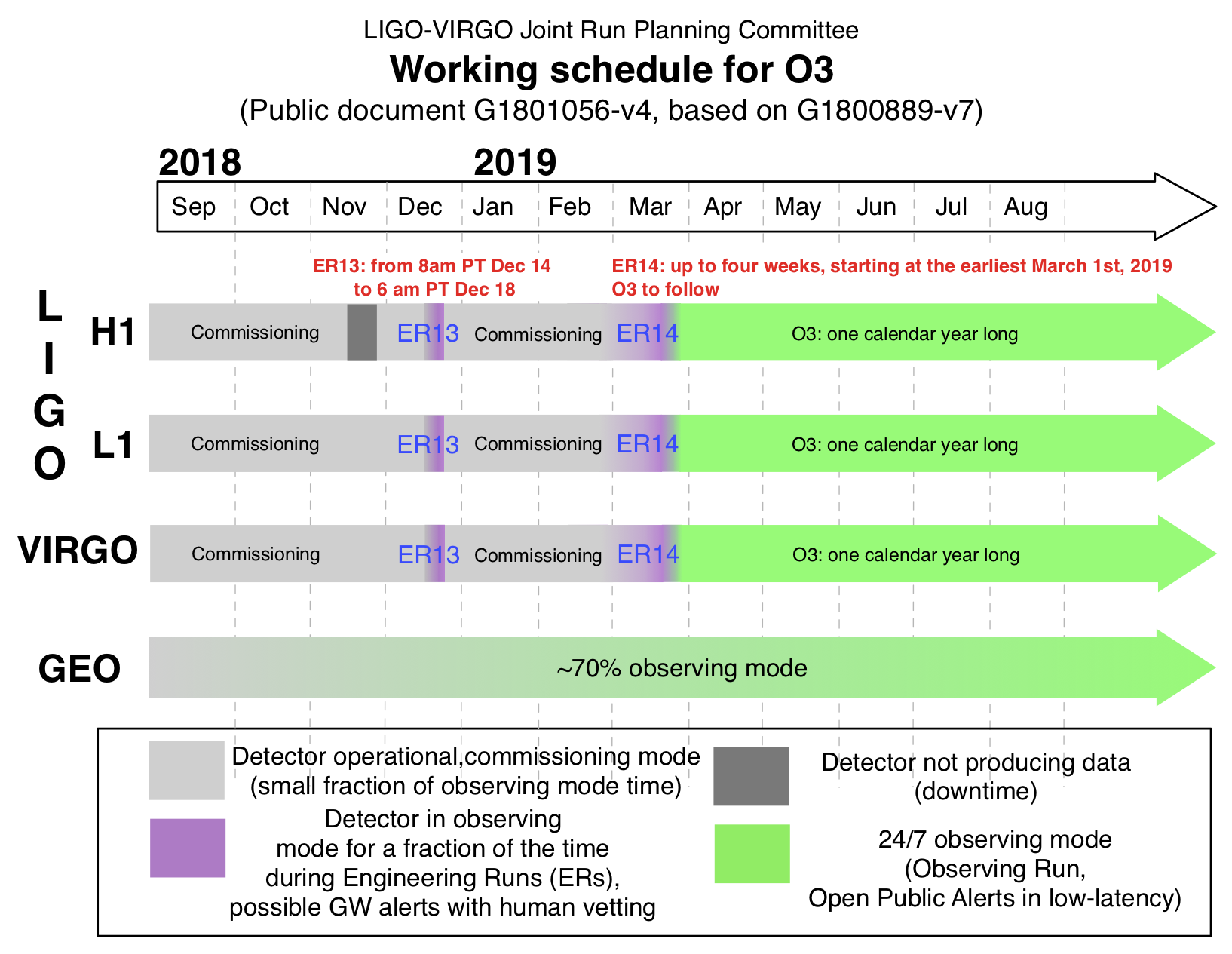Observing Capabilities¶
This section summarizes the observing capabilities of the global gravitational-wave detector network as of early 2019. This as a quick reference to the anticipated commissioning and observing schedule, sensitivity to gravitational-wave transients, and sky localization accuracy, as described in the following external documents:
- White Paper [1] on gravitational-wave data analysis and astrophysics
- Living Review [2] on prospects for observing and localizing gravitational-wave transients with Advanced LIGO, Advanced Virgo, and KAGRA
- Working Plan Towards O3 [3]
Timeline¶
The gravitational-wave observing schedules is divided into Observing Runs, epochs of months to years of operation at fixed sensitivity; down time for construction and commissioning; and transitional Engineering Runs between commissioning and observing runs. The long-term observing schedule is shown below. Since BNS mergers are a well-studied class of gravitational-wave signals, this figure gives the BNS range for each observing run.
Engineering Run 14 (ER14) started on 2019-03-04. The transition into Observing Run 3 (O3) occurred on 2019-04-01.
During O3, we expect that three facilities (LHO, LLO, and Virgo) will observe for one year. It is possible that the Japanese KAGRA detector may come online and become part of the international gravitational-wave network at some point during O3. The near-term observing schedule is shown below, reproduced from [3].

Live Status¶
There are a handful of public web pages that report live status of the LIGO/Virgo detectors and alert infrastructure.
- Detector Status Portal: Daily summary of detector performance.
- GWIStat: Real-time detector up/down status.
- LIGO Data Grid Status: Live dashboard showing up/down status of the detectors and online analyses. Status of the LIGO/Virgo alert pipeline is indicated by the “EMFollow” box.
Sensitivity and Sky Localization Accuracy¶
The following O3 projections are adapted from the Living Review [2] on prospects for observing and localizing gravitational-wave transients with Advanced LIGO, Advanced Virgo, and KAGRA. The BNS range and burst range (luminosity distance of detectable sources, averaged over sky position and source orientation) given the detectors’ anticipated sensitivities are listed in the table below.
| Detector | Range (Mpc) | |
|---|---|---|
| BNS | Burst | |
| LIGO | 120–170 | 75–90 |
| Virgo | 65–85 | 40–50 |
| KAGRA | 8–25 | |
We expect 1–10 BNS events over the course of O3. For BNS events, the median sky localization accuracy of in terms of the 90% credible area will be 120–180 deg². 12–21% of BNS mergers will be localized to less than 20 deg².
Event Rates¶
See the rates presentation from recent Town Hall meeting for LIGO and Virgo’s most current estimates of astrophysical rates of compact binary mergers.
| [1] | LIGO Scientific Collaboration & Virgo Collaboration 2018, The LSC-Virgo White Paper on Gravitational Wave Data Analysis and Astrophysics, LIGO Document T1800058-v1. https://dcc.ligo.org/LIGO-T1800058/public |
| [2] | (1, 2) Abbott, B. P., Abbott, R., Abbott, T. D., et al. 2018, Living Rev. Rel., 21, 3. doi:10.1007/s41114-018-0012-9 |
| [3] | (1, 2) LIGO Scientific Collaboration & Virgo Collaboration 2018, LIGO-Virgo Working Plan Towards O3, LIGO Document G1801056-v4. https://dcc.ligo.org/LIGO-G1801056/public |


